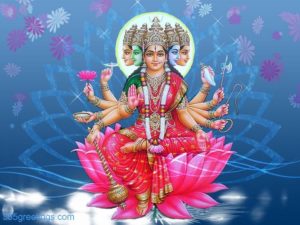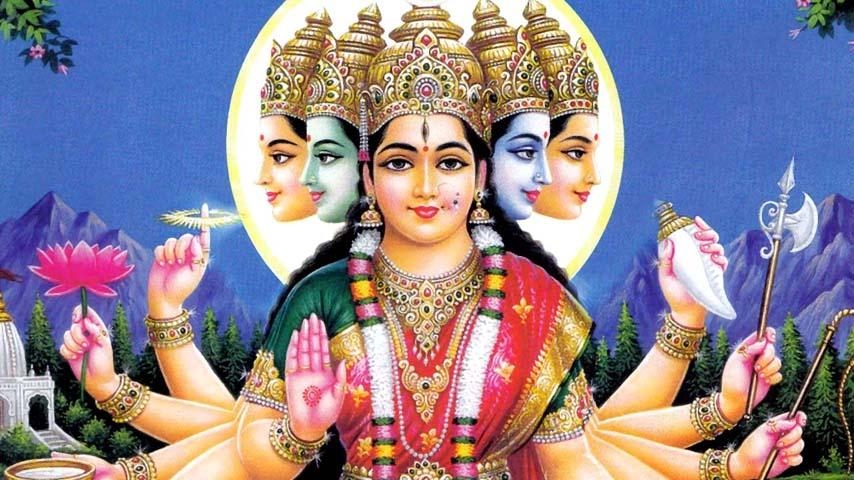
Gayatri Jayanti celebrates the manifestation of Goddess Gayatri, who is worshipped as Veda Mata (The Mother of Vedas). In 2020, the date of Gayatri Jayanti is June 1. Scholars also indicate that Sage Vishwamitra first uttered the Gayatri Mantra on the Jyeshtha Shukla Dashami day. And this day is observed as Gayatri Jayanti day.
Gayatri is a universal prayer that is addressed to the immanent and transcendent divine. The Gayatri Mantra is sacred and is considered the mother of the Vedas. It is non-denominational and can be chanted by anyone to illumine the intellect. It can be chanted upon waking, before the midday meal and in the evening – alone or in the company of the goodly and Godly.
What exactly is sandhya? San means well and dhya is derived from dhyana, so sandhya refers to proper or intense meditation (dhyana) on the Lord. It means concentration on the Godhead. To fix the mind on God, the activities have to be controlled. For success in that process of control, one should overcome the handicaps of the qualities (gunas), the pure, passionate, and dull (sathwa, rajas, and thamas). When these forces of natural impulse predominate and try to direct along their channels, one must pray to God to negate their pull. That is the first duty of the one who strives toward God. The rule of nature is that the morning is the period of pure (sathwic) quality, the noon of passionate (rajasic) quality, and the evening hour of dusk of dull (tamasic) quality. At dawn, the mind is awakened from the comfort of sleep liberated from agitations and depressions, so the mind is calm and clear. At that time, in that mental condition, meditation of the Lord is very fruitful, as everyone knows. This is why dawn worship (praathah-sandhya) is prescribed. But, ignorant of the significance, people continue doing the ritual in a blind mechanical way, simply because the ancients laid down the rule. The second duty is to perform the dawn worship, after realising the inner and the deeper meaning of the same.
As day progresses, one is infused with the passionate quality (rajoguna), the active effortful nature, and one enters the field of daily work and toil. Before one takes the midday food, one is directed to meditate on the Lord again and to dedicate the work, as well as the fruit derived through it, to the Lord Himself. One can start eating only after this act of devotion and grateful remembrance. This is the meaning of the noontime (maadhyamika) worship. By observing this ritual, passion is kept in check and is overpowered by the pure (sathwa) nature. This is the third duty of all people.
Then, people are possessed by a third nature, the dull (thamas). When evening descends, one hurries home, eats one’s fill, and is overpowered by sleep. But a duty still remains. To eat and sleep is the fate of idlers and drones. When the worst of the qualities (gunas), the dull (thamas), threatens to rule, one must make a special effort to escape its coils by resorting to prayer in the company of those who extol the Lord, reading about the glory of God, the cultivation of good virtues, and the purposeful nursing of good rules of conduct. This is the prescribed evening worship (sandhyavandana).
Therefore, the mind that emerges from the vacancy of sleep has to be properly trained and counselled; it must be made to feel that the bliss of meditation and the joy of being unaware of the outer world are much grander and more lasting than the comfort one gets by means of the daily dose of physical sleep. This bliss, this joy, can be felt and realised by all; discrimination will bring this home to you. This is the fourth duty of people.
People who, as long as they have life in them, observe the three-times-a-day worship are indeed of the highest type; they are ever glorious and attain all that is desired. Above all, they are liberated, even while alive (jivan-muktha).
On this day of Gayatri Jayanti, Venus is combust the Sun in Taurus; in Gemini, Mercury is strong in its own sign, and Rahu is retrograde in the nakshatra of Mars. Rahu takes the warrior energy of Mars, and the Vata from Gemini, plus the energy of the Lord of the Sign, Mercury, and continues the respiratory woes on Earth. If the masses could turn to Mother Gayatri and chant the Gayatri Mantra, they would receive the protection of the Most High.
We find the Moon in Uttara Phalguna nakshatra, indicating that kindness and generosity to one and all on the ease of lockdown of this pandemic worldwide is the order of the day. We can ground ourselves (earth sign) and others with our kindness and generosity toward others. This is the grace of Gayatri Maa made manifest in our thoughts, words and actions. We may place ourselves at the service of Mother Gayatri.
In Capricorn, Saturn and Jupiter are retrograde. Saturn cancels the debilitation of Jupiter, and Jupiter is vargottama with the Navamsha, making its energy strong. Combine this energy with that of Saturn, we get patience, perseverance and positivity which equals resilience. Mother Gayatri is the embodiment of resilience, purpose, non-duality and oneness with Divinity. On this day of Gayatri Jayanti, let us take up the eternal resilience of our Universal Mother, enlighten our intellects with her self-effulgent light and proceed, day by day, step by step, with patience, perseverance and positivity.
What is the real meaning of the word Gayatri? The word is taken to mean either a Goddess or a formula. Gayatri is that which protects (thra) the life breaths (gayas or pranas) or the senses (indriyas), beginning with speech. Besides, it is said, That which saves those who sing it, revere it, repeat it, or meditate on it is called Gayatri. Gaayantham thraayathe yasmaath Gayatri, thena kathyathe. That is to say, it is this sacred mantra that transformed a royal sage (rajarshi) like Viswamitra into a brahmanical sage (brahmarshi). The mother that is the Veda (Vedamatha) will confer all boons on all those who worship Her. That Goddess is described in glorious terms in the Brahmanas and in the texts on dharma (dharma-sutras); if you understand these clearly, you can realize it, unaided.

![]()
